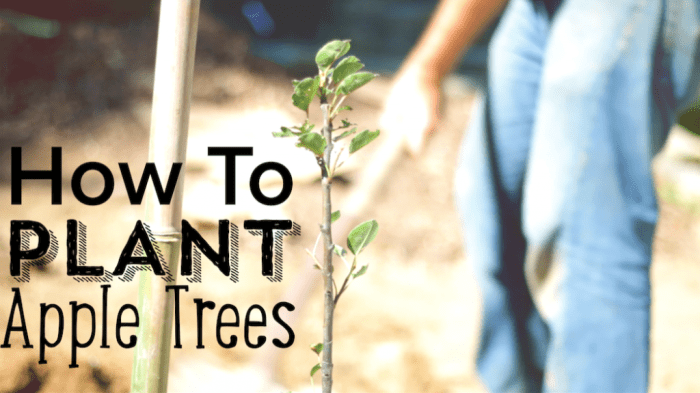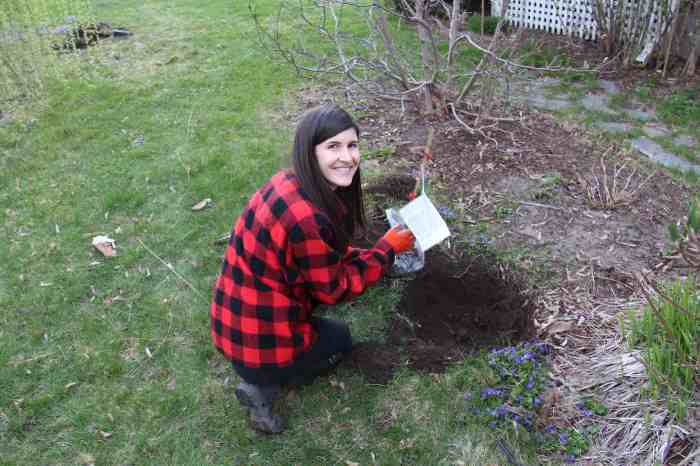Ideal Planting Time in NY

When to plant apple trees in ny – Planting apple trees in New York State is a rewarding endeavor, leading to bountiful harvests of crisp, juicy fruit. Timing is crucial for success, however, as the climate varies significantly across the state. Understanding the ideal planting window for your specific region and apple variety will significantly increase your chances of a thriving orchard.
Optimal Planting Time Frame in New York
The best time to plant apple trees in New York is during the dormant season, typically between late fall (after leaf drop) and early spring (before bud break). This period allows the trees to establish a strong root system before the growing season begins. However, the precise timing varies depending on the specific region and microclimate, as well as the variety of apple tree.
Generally, planting should occur when the ground is workable but not frozen. Avoid planting when the ground is excessively wet or soggy, as this can damage the roots.
Planting Dates for Different Apple Varieties
Early-season apple varieties, such as Paula Red or Lodi, are best planted in early to mid-fall, allowing them ample time to establish roots before winter. Mid-season varieties, like Honeycrisp or Gala, can be planted either in late fall or early spring. Late-season varieties, such as Fuji or Red Delicious, are often planted in early spring, after the last frost, to minimize the risk of winter damage to new growth.
Specific planting dates will depend on your location’s climate.
Impact of Last Frost Dates on Apple Tree Planting Success
The last frost date significantly impacts apple tree planting success. Planting too early exposes young trees to the risk of frost damage, which can kill buds, blossoms, and even young branches. Consulting your local agricultural extension office or using online resources to find the average last frost date for your specific county is highly recommended. For example, areas in the warmer southern tier of New York may have last frost dates in early to mid-April, while northern counties might experience frost well into May.
This difference necessitates adjusted planting schedules to ensure survival and healthy growth.
Recommended Planting Months by Region and Variety
The following table provides a general guideline for recommended planting months in different regions of New York, categorized by apple variety type. Remember that these are guidelines, and local conditions should always be considered. Always check the soil conditions before planting to ensure they are suitable for root development.
| Region | Early Season | Mid Season | Late Season |
|---|---|---|---|
| Western NY | October-November | October-November or March-April | March-April |
| Central NY | October-November | October-November or March-April | March-April |
| Eastern NY | October-November | October-November or March-April | March-April |
| Long Island | November-December | November-December or March-April | March-April |
Planting Techniques and Aftercare

Planting your apple tree correctly and providing diligent aftercare are crucial for its long-term health and bountiful harvests. These initial steps will determine the tree’s success for years to come, transforming your efforts into a rewarding experience of watching your tree flourish. Let’s explore the key techniques to ensure your apple tree thrives in New York’s climate.
Digging the Hole and Positioning the Tree
Proper hole preparation is essential for successful apple tree planting. Dig a hole significantly wider than the root ball, but approximately the same depth. This allows the roots to spread easily and establish themselves. The wider hole encourages outward root growth, crucial for stability and nutrient uptake. Gently loosen the soil at the bottom of the hole to further aid root penetration.
Before placing the tree, carefully inspect the root system. Remove any circling or damaged roots. Position the tree so the graft union (the point where the scion is grafted onto the rootstock) is above the soil line. This prevents the scion from rooting and potentially altering the fruit characteristics. Backfill the hole with the original soil, ensuring no air pockets remain.
Gently firm the soil around the base of the tree.
Watering and Mulching Techniques
Consistent watering is vital, especially during the first year. Water deeply and regularly, aiming for about one inch of water per week, depending on rainfall. Avoid shallow watering, which encourages shallow root growth. Mulching helps retain soil moisture, suppress weeds, and regulate soil temperature. Apply a 2-4 inch layer of organic mulch, such as wood chips or shredded bark, around the base of the tree, keeping it a few inches away from the trunk to prevent rot.
Right, so planting apple trees in NY, best bet’s usually spring or autumn, innit? But if you’re thinking of something a bit different, check out this link for info on how to plant red maple tree , they’re lush. Then, once you’ve got your head around that, you can totally smash planting those apple trees, no probs.
Staking and Pest/Disease Protection
Staking provides support for young apple trees, especially in windy areas. Use a sturdy stake and tie the tree loosely to the stake with soft material to prevent girdling (damaging the bark). Regular inspection is crucial for early pest and disease detection. Look for signs of insect infestations, such as leaf damage or holes, and fungal diseases, such as leaf spots or cankers.
Early intervention is key. Consider using organic pest control methods, such as insecticidal soap or neem oil, and appropriate fungicides if necessary, always following label instructions carefully.
Pruning Young Apple Trees
Pruning young apple trees encourages strong framework development and future fruit production. The initial pruning should focus on establishing a central leader and well-spaced scaffold branches. Remove any crossing, rubbing, or inward-growing branches. This allows for good air circulation and sunlight penetration, reducing the risk of diseases. Regular pruning in subsequent years will maintain the tree’s shape and promote fruit bud formation.
Use sharp, clean pruning shears to make clean cuts, avoiding ragged edges that can invite disease.
Dealing with Pests and Diseases: When To Plant Apple Trees In Ny

A thriving apple orchard in New York requires vigilance against various pests and diseases. Understanding these challenges and implementing proactive strategies is key to a bountiful harvest. Early detection and appropriate management are crucial for maintaining the health and productivity of your apple trees. This section will Artikel common threats, preventative measures, and effective control methods, empowering you to cultivate a resilient and fruitful orchard.
Common Apple Tree Pests and Diseases in New York
Apple trees in New York face a range of pests and diseases, each with distinct symptoms and management requirements. Ignoring these issues can lead to reduced yields, weakened trees, and even death. Recognizing these problems early allows for timely intervention, maximizing the chances of a healthy and productive orchard.
- Apple scab (Venturia inaequalis): This fungal disease manifests as olive-green to brown, velvety spots on leaves and fruit. Control involves sanitation, resistant varieties, and fungicide applications. Organic options include sulfur-based sprays and copper fungicides.
- Cedar apple rust (Gymnosporangium juniperi-virginianae): This fungal disease alternates between apple trees and juniper bushes. On apples, it causes orange-yellow spots on leaves and fruit, often with orange, gelatinous growths. Control involves removing nearby junipers or applying fungicides. Organic options include horticultural oils.
- Powdery mildew (Podosphaera leucotricha): This fungal disease appears as a white, powdery coating on leaves, shoots, and fruit. It can stunt growth and reduce fruit quality. Control involves good air circulation, resistant varieties, and fungicides. Organic options include potassium bicarbonate.
- Codling moth (Cydia pomonella): This insect pest bores into apples, causing wormholes and fruit damage. Control involves pheromone traps, burlap bands to trap larvae, and insecticide applications. Organic options include Bacillus thuringiensis (Bt) sprays.
- Apple maggot (Rhagoletis pomonella): The larvae of this fly burrow into apples, creating tunnels and rendering the fruit unmarketable. Control involves trapping adult flies, bagging fruit, and insecticide applications. Organic options include kaolin clay sprays.
Preventative Measures for Pest and Disease Management
Prevention is always the best approach to managing pests and diseases. By implementing proactive strategies, you significantly reduce the risk of infestations and outbreaks, minimizing the need for extensive interventions later on.
Key preventative measures include selecting disease-resistant apple varieties suited to New York’s climate; ensuring proper tree spacing for adequate air circulation to discourage fungal growth; maintaining orchard hygiene through regular sanitation practices like removing fallen leaves and fruit, which can harbor pests and diseases; and monitoring your trees regularly for early signs of infestation or disease. A healthy, well-maintained tree is much more resilient to pests and diseases.
Organic and Chemical Control Methods, When to plant apple trees in ny
Organic and chemical control methods offer different approaches to managing apple tree pests and diseases. The choice depends on personal preferences, the severity of the problem, and the scale of the orchard.
Organic Control: Organic methods prioritize natural solutions, minimizing environmental impact. These often involve using beneficial insects, horticultural oils, neem oil, and microbial insecticides like Bacillus thuringiensis (Bt). Organic fungicides such as copper sprays and sulfur are also available. These methods often require more frequent applications and may not be as effective as chemical controls in severe infestations. However, they are a safer option for the environment and human health.
Chemical Control: Chemical controls offer faster and more potent results, often necessary for severe infestations. However, they should be used judiciously, following label instructions carefully to minimize environmental impact and potential health risks. Chemical pesticides and fungicides are highly effective but require careful application and consideration of potential harm to beneficial insects and pollinators.
Commonly Asked Questions
What type of soil is best for apple trees in NY?
Well-drained, slightly acidic loam is ideal. Avoid heavy clay soils that retain too much water.
How far apart should I plant apple trees?
Spacing depends on the variety, but generally, allow 15-25 feet between trees.
Do apple trees need pollinators?
Most apple varieties require cross-pollination from another compatible variety. Check the variety description for pollination needs.
When should I prune my newly planted apple tree?
Light pruning can be done in late winter or early spring before new growth begins.
